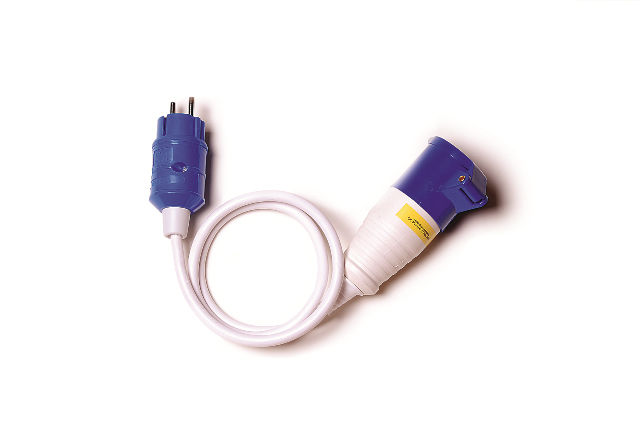Camping on the continent

A two-pin European adapter cable
Camping in Europe can offer a few additional challenges to UK campers. Fortunately, with the coming of standardisation within the European Union, voltage supply problems are fewer than before.
In general modern UK appliances will work in Europe even where a 220V supply is the norm.
The available power from continental hook-up points will often be less than the UK and a supply as little as 5A or 6A is common.
Even though the blue plug and hook-up sockets we use in the UK are to a European standard, many continental sites still have old style two-pin hook-ups or a mixture of modern and old types. In general there are two types of old-style sockets, both have the two-pin arrangement, but they differ in how the earth connection is made. Connecting to these old-style sockets is relatively easy with the use of a continental adapter lead, which is readily available in camping and caravan accessory shops.
The adapter will normally come with two pins and socket for an earth pin, suitable for the old French-style sockets and also side earth strips, making it suitable for old German-style sockets.
Whether the site provides modern or a two-pin connection, there is always the possibility that the electrical supply will be wired differently (double-pole) where both live and neutral are disconnected with the switch, unlike most UK wiring where only the live wire is disconnected (single-pole). If the live wire is presented to your electrical connection on the neutral side, this is known as reversed polarity (see inset box). Most modern electrical supply units will have a built in tester otherwise a proprietary mains tester can be bought for a small cost that can be plugged into a socket and will show up reverse polarity and identify other problems with earth connections. Should you have indication of an earth problem – whether in Europe or in the UK – you should not use the hook-up supply.
If faced with a reverse polarity situation it is possible to make up a short adapter lead to deal with reverse polarity, where the wiring within one end of the lead is reversed. You should only prepare such an adapter if you are sufficiently competent. Make sure that the adapter is clearly marked to indicate that the wiring is reversed.
Reverse polarity explained
This is a situation where the live cable is connected to the neutral side of the circuit. In a single-pole circuit found in the UK in older installations only the live is disconnected when the user switches the socket off. The neutral can still allow current to flow. So when the connections are reversed the supply can flow even when the socket switch is off. On a modern double-pole installation this is not a problem, however it is always worthwhile unplugging items that have exposed elements such as toasters and electric fires.